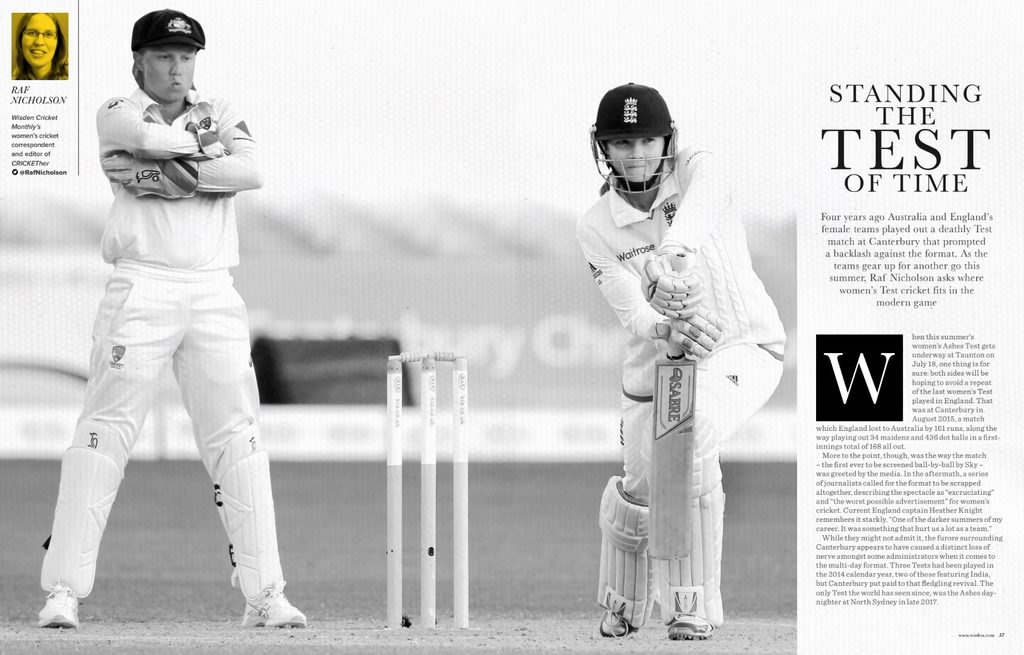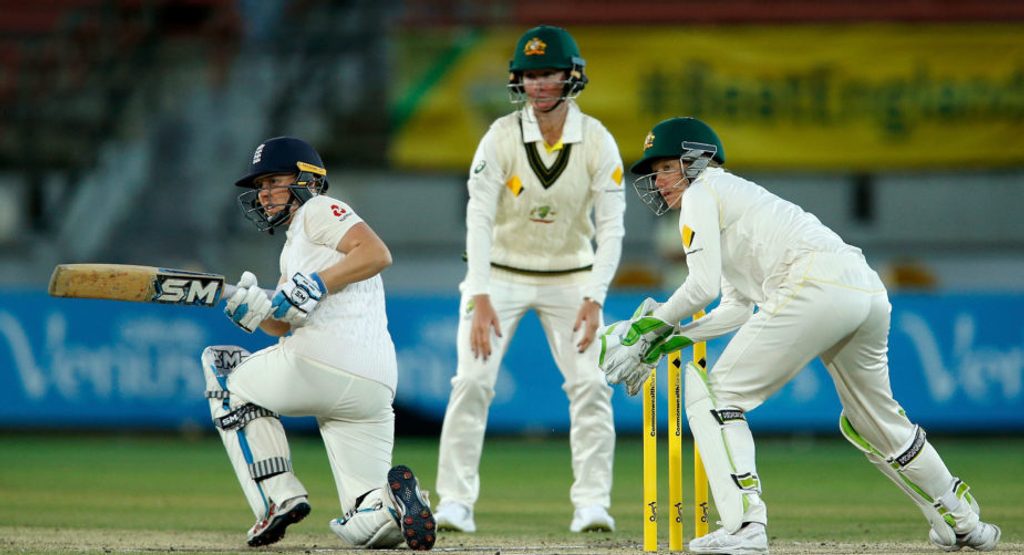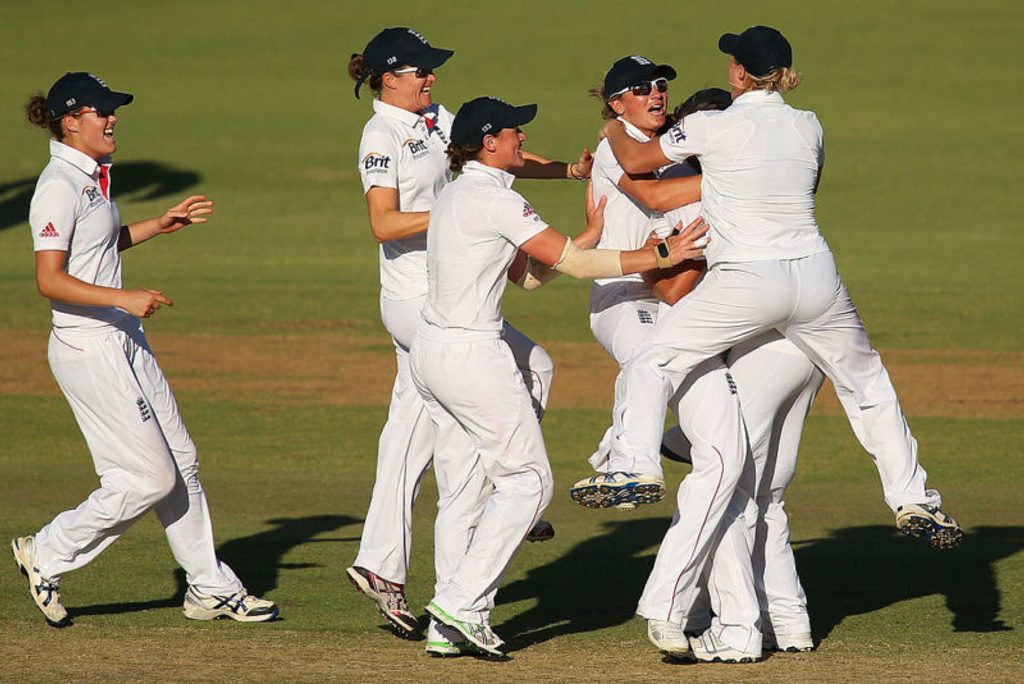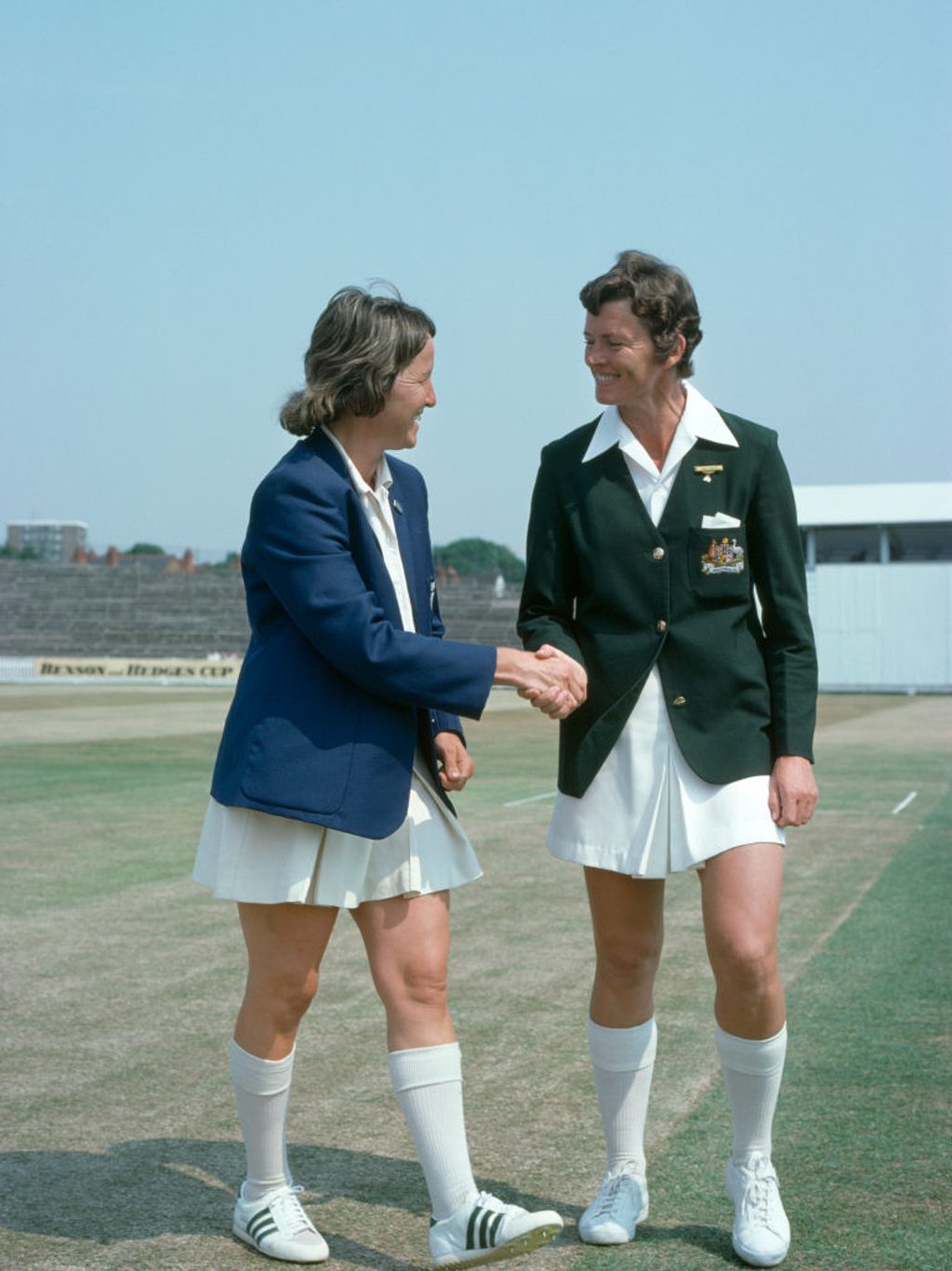
Four years ago Australia and England’s female teams played out a deathly Test match at Canterbury that prompted a backlash against the format. With the teams in action this summer, Raf Nicholson, writing for Wisden Cricket Monthly, asks where women’s Test cricket fits in the modern game.
This article was first published in issue 21 of Wisden Cricket Monthly. Subscribe here
When this summer’s Women’s Ashes Test gets underway at Taunton on July 18, one thing is for sure: both sides will be hoping to avoid a repeat of the last women’s Test played in England. That was at Canterbury in August 2015, a match which England lost to Australia by 161 runs, along the way playing out 34 maidens and 436 dot balls in a first-innings total of 168 all out.
[breakout id=”1″][/breakout]
More to the point, though, was the way the match – the first ever women’s Test to be screened ball-by-ball by Sky – was greeted by the media. In the aftermath, a series of journalists called for the format to be scrapped altogether, describing the spectacle as “excruciating” and “the worst possible advertisement” for women’s cricket. Current England captain Heather Knight remembers it starkly. “One of the darker summers of my career. It was something that hurt us a lot as a team.”
England Women have announced their 14-member squad for the first game of the multi-format Ashes. ?https://t.co/samIeyrRtP
— Wisden (@WisdenCricket) June 30, 2019
While they might not admit it, the furore surrounding the Canterbury Test appears to have caused a distinct loss of nerve amongst some administrators when it comes to the multi-day format. Three Tests had been played in the 2014 calendar year, two of those featuring India, but Canterbury put paid to that fledgling revival. The only Test the world has seen since was the Ashes day-nighter at North Sydney in late 2017.
During that match Cricket Australia’s Belinda Clark, a leading member of the ICC’s Women’s Committee, appeared live on air to reiterate the ICC’s policy on women’s Tests, which involves exclusively focusing on the shorter formats. “If we’re thinking about growth of the international game, the answer to that question is T20,” she said. “I’m not sure that women’s Test cricket holds a place in people’s hearts.”
[breakout id=”0″][/breakout]
Women’s Tests have been played since December 1934 when a group of English pioneers, led by the formidable Betty Archdale, sailed to Australia and New Zealand to play out the first-ever women’s internationals. Since then South Africa (in 1960), India (in 1976) and West Indies (also 1976) have joined the fray, with Pakistan, Sri Lanka, Ireland and even the Netherlands also participating in the odd Test along the way.
Until the ICC took over control of women’s cricket in 2005, the format was one which was highly valued by the game’s administrators: a survey conducted by the International Women’s Cricket Council in 2000 showed that “all countries indicated support for a combination of Test and one-day cricket”. A multi-Test series, now seemingly a distant dream, was for many years the norm.
[caption id=”attachment_112061″ align=”alignnone” width=”800″] This article was first published in issue 21 of Wisden Cricket Monthly. Subscribe here[/caption]
This article was first published in issue 21 of Wisden Cricket Monthly. Subscribe here[/caption]
The ICC, though, now runs the show; and commercial realities have come to dictate the number of women’s Test matches. In the last decade, only eight have been played. Hosting Tests is expensive, and provides little financial return compared with the ubiquitous crowd-puller that is T20. Arguably the money is better spent in other ways, such as paying the players, with all teams now moving towards full professionalism.
[caption id=”attachment_55694″ align=”alignnone” width=”800″] Heather Knight bats in the Women’s Ashes Test match at North Sydney Oval, November 12, 2017[/caption]
Heather Knight bats in the Women’s Ashes Test match at North Sydney Oval, November 12, 2017[/caption]
The problem now being faced is that the lack of multi-day cricket leads to a situation where female players have little familiarity with it and struggle to adapt their game. Both sides will play one three-day warm-up ahead of Taunton this summer, and that will be that in terms of preparation. “The mental side of Test cricket is hard,” says Knight. “I remember when I hit 157 in the Wormsley Test in 2013, I was drained for days afterwards. You have to learn on the job.”
Anya Shrubsole, veteran of five Tests, concurs. “You’re learning to play a format of the game while playing it. There was a lot of criticism around the Canterbury Test, but to go and play a format as a one-off every two years that you never play otherwise – it’s hard to get that right all the time.”
[caption id=”attachment_111626″ align=”alignnone” width=”800″] England beat the hosts Australia by 61 runs in Perth in 2014[/caption]
England beat the hosts Australia by 61 runs in Perth in 2014[/caption]
Might it be better, then, to just give up the ghost and abandon women’s Test cricket altogether? Not according to the players. “One of the benefits of not playing it very often is it’s so exciting when it comes around,” Shrubsole says. “It’s the same as a World Cup – you only play one every four years, so when they come around they’re so unbelievably special.”
There is certainly a real sense that, of all the matches this summer, it is the Test at Taunton that players from both sides are desperate to play in – making a nonsense of Clark’s statement that women’s Test cricket fails to ‘claim a place in people’s hearts’. “I’m so excited to pull on the whites,” says the usually placid Knight. “I’d absolutely love to play more Tests.”
?NEW PODCAST?
?️@meljones_33
?️@Yas_Wisden
?️@Phil_WisdenON:
– Another Trent Bridge thriller
– The buzz of #CWC19
– The Women’s Ashes
– @SomersetCCC‘s @CountyChamp season + much moreListen/subscribe on the Podcast App or Spotify.https://t.co/UzOezjw7nf
— Wisden (@WisdenCricket) June 7, 2019
And why wouldn’t they, given that Test cricket remains the premier format in the men’s game? As former Australia international Mel Jones said on a recent Wisden podcast: “I grew up, as did all these players, watching Test match cricket on the TV and knowing that that’s the pinnacle. To get your baggy green, for any Australian cricketer, is the ultimate. We need to allow that opportunity to unfold too for the women.” It seems undoubtedly true that to deny women the opportunity to participate in Test cricket is to deny them a fundamental element of cricketing equality.
[breakout id=”6″][/breakout]
So what’s the answer? More multi-day cricket for women at domestic level, perhaps? More Tests between different nations, so that instead of one Test every two years it becomes every few months? No doubt the debates will continue to rage. For now, fingers crossed that both teams can produce a thriller at Taunton. The world will be watching.
The Long Game: A Short History
[breakout id=”2″][/breakout]
[caption id=”attachment_112053″ align=”alignnone” width=”800″] England Women’s captain Rachael Heyhoe-Flint shakes hands with Australia Women’s captain Anne Gordon[/caption]
England Women’s captain Rachael Heyhoe-Flint shakes hands with Australia Women’s captain Anne Gordon[/caption]
[breakout id=”3″][/breakout]
[breakout id=”4″][/breakout]
[caption id=”attachment_112058″ align=”alignnone” width=”652″] Clare Connor went on to claim 24 wickets and 502 runs in 16 Tests, as well as featuring in 93 ODIs[/caption]
Clare Connor went on to claim 24 wickets and 502 runs in 16 Tests, as well as featuring in 93 ODIs[/caption]
[breakout id=”5″][/breakout]







